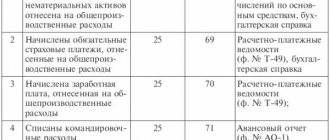Procedure for accounting for expenses for income tax purposes
Date of publication: 03/02/2016 12:53 (archive)
Article 272 of the Tax Code of the Russian Federation establishes the procedure for recognizing expenses using the accrual method.
Expenses accepted for tax purposes are recognized as such in the reporting (tax) period to which they relate, regardless of the time of actual payment of funds and (or) other form of payment and are determined taking into account the provisions of Articles 318 - 320 of the Code.
In accordance with Article 252 of the Tax Code of the Russian Federation, expenses are recognized as justified and documented expenses, and in cases provided for in Article 265 of the Tax Code of the Russian Federation, losses incurred (incurred) by the taxpayer.
Documented expenses mean expenses confirmed by documents drawn up in accordance with the legislation of the Russian Federation, or documents drawn up in accordance with business customs applied in the foreign state in whose territory the corresponding expenses were made, and (or) documents indirectly confirming expenses incurred, including a customs declaration, a business trip order, travel documents, a report on work performed in accordance with the contract. Any expenses are recognized as expenses, provided that they are incurred to carry out activities aimed at generating income.
Article 11 of the Tax Code of the Russian Federation establishes that the institutions, concepts of civil, family and other branches of legislation of the Federation used in the Code are applied in the meaning in which they are used in these branches of legislation, unless otherwise provided by the Code.
In accordance with Article 9 of the Federal Law of December 6, 2011 No. 402-FZ “On Accounting,” each fact of economic life is subject to registration as a primary accounting document. The primary accounting document must be drawn up when a fact of economic life is committed, and if this is not possible, immediately after its completion.
Thus, accounting legislation allows you to generate a document confirming expenses incurred after the reporting date, but immediately after the end of the provision of services for the month.
Article 289 of the Tax Code of the Russian Federation establishes that taxpayers, regardless of whether they have an obligation to pay tax and (or) advance payments for tax, the specifics of calculation and payment of tax, are required to submit at the end of each reporting and tax period to the tax authorities at their location and the location of each separate division of the relevant tax returns.
Thus, if the primary accounting document confirming the provision of ongoing services for the past month was drawn up immediately after the end of the month in which the fact of economic life was committed, within a reasonable period, but before the date of submission of the declaration (before the 28th day), then such primary documents confirming expenses incurred should be taken into account in the reporting period to which they relate, which should be indicated in the document.
Expenses for ordinary activities
5. Expenses for ordinary activities are expenses associated with the manufacture of products and the sale of products, the acquisition and sale of goods. Such expenses also include expenses the implementation of which is associated with the performance of work or provision of services. In organizations whose subject of activity is the provision for a fee for temporary use (temporary possession and use) of their assets under a lease agreement, expenses for ordinary activities are considered expenses the implementation of which is associated with this activity. In organizations whose subject of activity is the provision for a fee of rights arising from patents for inventions, industrial designs and other types of intellectual property, expenses for ordinary activities are considered expenses the implementation of which is associated with this activity. In organizations whose subject of activity is participation in the authorized capital of other organizations, expenses for ordinary activities are considered expenses the implementation of which is related to this activity. Expenses, the implementation of which is associated with the provision for a fee for temporary use (temporary possession and use) of one’s assets, rights arising from patents for inventions, industrial designs and other types of intellectual property, and from participation in the authorized capital of other organizations, when this is not the subject of the organization's activities are classified as operating expenses. Expenses for ordinary activities are also considered to be reimbursement of the cost of fixed assets, intangible assets and other depreciable assets, carried out in the form of depreciation charges.
6. Expenses for ordinary activities are accepted for accounting in an amount calculated in monetary terms equal to the amount of payment in cash and other forms or the amount of accounts payable (taking into account the provisions of paragraph 3 of these Regulations). If payment covers only part of the recognized expenses, then the expenses accepted for accounting are determined as the sum of payment and accounts payable (in the part not covered by payment). 6.1. The amount of payment and (or) accounts payable is determined based on the price and conditions established by the agreement between the organization and the supplier (contractor) or other counterparty. If the price is not provided for in the contract and cannot be established based on the terms of the contract, then to determine the amount of payment or accounts payable, the price at which, in comparable circumstances, the organization usually determines expenses in relation to similar inventories and other valuables, works, services is accepted. or providing for temporary use (temporary possession and use) of similar assets. 6.2. When paying for purchased inventories and other valuables, works, services on the terms of a commercial loan provided in the form of deferred and installment payment, expenses are accepted for accounting in the full amount of accounts payable. 6.3. The amount of payment and (or) accounts payable under contracts providing for the fulfillment of obligations (payment) not in cash is determined by the value of goods (valuables) transferred or to be transferred by the organization. The cost of goods (valuables) transferred or to be transferred by an organization is established based on the price at which, in comparable circumstances, the organization usually determines the cost of similar goods (valuables). If it is impossible to determine the value of goods (valuables) transferred or to be transferred by the organization, the amount of payment and (or) accounts payable under contracts providing for the fulfillment of obligations (payment) not in cash is determined by the value of the products (goods) received by the organization. The cost of products (goods) received by the organization is established based on the price at which similar products (goods) are purchased in comparable circumstances. 6.4. In the event of a change in the obligation under the contract, the initial amount of payment and (or) accounts payable is adjusted based on the value of the asset to be disposed of. The value of the asset to be disposed of is determined based on the price at which, in comparable circumstances, the entity would normally determine the value of similar assets. 6.5. The amount of payment and (or) accounts payable is determined taking into account all discounts (discounts) provided to the organization in accordance with the agreement. 6.6. The amount of payment is determined (decreased or increased) taking into account the amount differences that arise in cases where payment is made in rubles in an amount equivalent to the amount in foreign currency (conventional monetary units). The amount difference is understood as the difference between the ruble estimate of the actual payment made, expressed in foreign currency (conventional monetary units), calculated at the official or other agreed rate on the date of acceptance of the corresponding accounts payable for accounting, and the ruble estimate of these accounts payable, calculated at the official or other agreed rate. other agreed rate on the date of recognition of the expense in accounting.
7. Expenses for ordinary activities form:
- expenses associated with the acquisition of raw materials, materials, goods and other inventories;
- expenses arising directly in the process of processing (refinement) of inventories for the purposes of production, performance of work and provision of services and their sale, as well as sale (resale) of goods (expenses for the maintenance and operation of fixed assets and other non-current assets, as well as to maintain them in good condition, commercial expenses, administrative expenses, etc.).
8. When forming expenses for ordinary activities, their grouping should be ensured by the following elements:
- material costs;
- labor costs;
- contributions for social needs;
- depreciation;
- other costs.
For management purposes, accounting organizes the accounting of expenses by cost items. The list of cost items is established by the organization independently.
9. For the purpose of generating an organization’s financial result from ordinary activities, the cost of goods, products, works, services sold is determined, which is formed on the basis of expenses for ordinary activities recognized both in the reporting year and in previous reporting periods, and carryover expenses related to the receipt of income in subsequent reporting periods, taking into account adjustments depending on the characteristics of production, performance of work and provision of services and their sale, as well as the sale (resale) of goods. At the same time, commercial and administrative expenses may be recognized in the cost of sold products, goods, works, services in full in the reporting year of their recognition as expenses for ordinary activities.
10. The rules for accounting for costs of production, sale of goods, performance of work and provision of services in the context of elements and articles, calculation of the cost of products (works, services) are established by separate regulations and guidelines for accounting.
Disclosure of information in financial statements
20. As part of the information on the accounting policy of the organization in the financial statements, the procedure for recognizing commercial and administrative expenses must be disclosed.
21. In the profit and loss statement, the organization's expenses are reflected subdivided into the cost of goods sold, products, works, services, selling expenses, administrative expenses, operating expenses and non-operating expenses, and, if incurred, extraordinary expenses. 21.1. If the income statement identifies types of income, each of which individually constitutes five or more percent of the organization’s total income for the reporting year, it shows the portion of expenses corresponding to each type. 21.2. Operating and non-operating expenses may not be shown in the income statement in relation to the corresponding income when:
- the relevant accounting rules provide for or do not prohibit such recognition of expenses;
- expenses and related income arising as a result of the same or similar fact of economic activity are not significant for characterizing the financial position of the organization.
22. At least the following information is also subject to disclosure in the financial statements:
- expenses for ordinary activities by cost elements;
- change in the amount of expenses not related to the calculation of the cost of products, goods, works, services sold in the reporting year;
- expenses equal to the amount of deductions in connection with education in accordance with the rules of accounting for reserves (forthcoming expenses, estimated reserves, etc.).
23. Other expenses of the organization for the reporting year, which, in accordance with the accounting rules, are not credited to the profit and loss account in the reporting year, are subject to disclosure in the financial statements separately.
Recognition rules in financial statements. results
Expenses are recognized in the income statement based on the following rules:
- taking into account the relationship between expenses incurred and revenues (correspondence between income and expenses);
- by their reasonable distribution between reporting periods - when expenses determine the receipt of income over several reporting periods and when the relationship between income and expenses cannot be clearly defined or is determined indirectly;
- for expenses recognized in the reporting period when the non-receipt of economic benefits (income) or receipt of assets becomes determined;
- regardless of how they are accepted for the purposes of calculating the tax base;
- when obligations arise that are not caused by the recognition of the corresponding assets.
other expenses
11. Operating expenses are:
- expenses associated with the provision for a fee for temporary use (temporary possession and use) of the organization’s assets (taking into account the provisions of paragraph 5 of these Regulations);
- costs associated with the provision for a fee of rights arising from patents for inventions, industrial designs and other types of intellectual property;
- expenses associated with participation in the authorized capitals of other organizations (taking into account the provisions of paragraph 5 of these Regulations);
- expenses associated with the sale, disposal and other write-off of fixed assets and other assets other than cash (except foreign currency), goods, products;
- interest paid by an organization for providing it with funds (credits, borrowings) for use;
- expenses related to payment for services provided by credit institutions;
- other operating expenses.
12. Non-operating expenses are:
- fines, penalties, penalties for violation of contract terms;
- compensation for losses caused by the organization;
- losses of previous years recognized in the reporting year;
- amounts of receivables for which the statute of limitations has expired, and other debts that are unrealistic for collection;
- exchange differences;
- the amount of depreciation of assets (except for non-current assets);
- other non-operating expenses.
13. Extraordinary expenses include expenses that arise as a consequence of emergency circumstances of economic activity (natural disaster, fire, accident, nationalization of property, etc.).
14. For accounting purposes, the amount of other expenses is determined in the following order. 14.1. The amount of expenses associated with the sale, disposal and other write-off of fixed assets and other assets other than cash (except foreign currency), goods, products, as well as participation in the authorized capital of other organizations, with provision for a fee for temporary use (temporary ownership and use) of the organization's assets, rights arising from patents for inventions, industrial designs and other types of intellectual property (when this is not the subject of the organization's activities), interest paid by the organization for providing it with funds for use, as well as expenses associated with payment for services provided by credit institutions are determined in a manner similar to that provided for in paragraph 6 of these Regulations. 14.2. Fines, penalties, penalties for violation of the terms of contracts, as well as compensation for losses caused by the organization are accepted for accounting in amounts awarded by the court or recognized by the organization. 14.3. Accounts receivable for which the statute of limitations has expired and other debts that are unrealistic for collection are included in the organization's expenses in the amount in which the debt was reflected in the organization's accounting records. 14.4. The amounts of depreciation of assets (except for non-current assets) are determined in accordance with the rules established for the revaluation of assets.
15. Other expenses are subject to crediting to the organization’s profit and loss account, unless a different procedure is established by law or accounting rules.
Conditions of recognition
The key conditions for recognizing expenses in accounting are as follows:
- the expense takes place in accordance with a specific agreement/legislative and regulatory requirements/business customs;
- the amount of expenditure can be determined;
- there is certainty that a particular transaction will result in a reduction in the entity's economic benefits (i.e. the entity has transferred the asset or there is no uncertainty about its transfer).
Also see “Main types of costs in production”.
The basic principles for recognizing expenses in accounting are as follows: if at least one of the listed conditions is not met in relation to any expenses incurred by an organization, then in accounting it recognizes receivables.
Also see “Accounting for accounts receivable in accounting: to which account should it be attributed?”
Depreciation is recognized as an expense based on the amount of depreciation charges - based on:
- the value of depreciable assets;
- their useful life;
- methods adopted by the organization for calculating depreciation.







